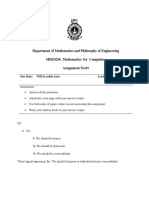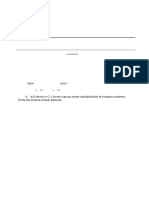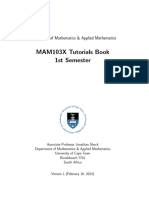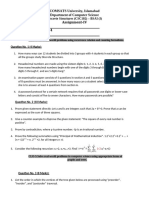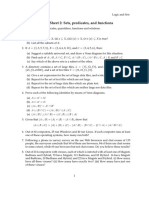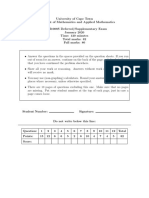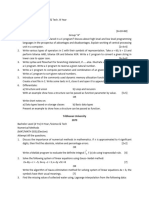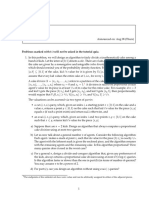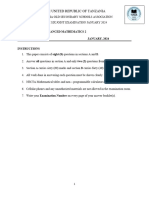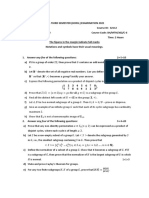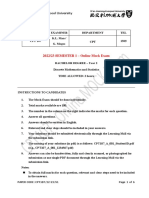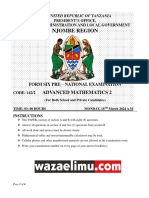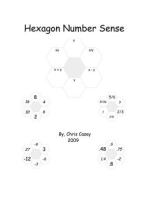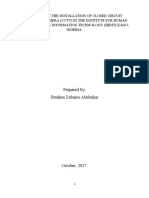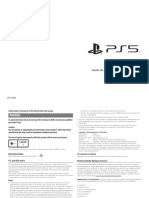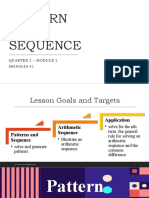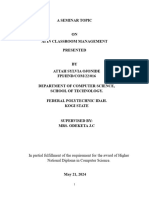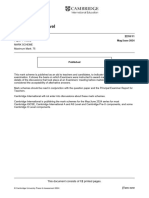Da DMGT
Da DMGT
Uploaded by
Shaurya 22BAI1173Copyright:
Available Formats
Da DMGT
Da DMGT
Uploaded by
Shaurya 22BAI1173Original Title
Copyright
Available Formats
Share this document
Did you find this document useful?
Is this content inappropriate?
Copyright:
Available Formats
Da DMGT
Da DMGT
Uploaded by
Shaurya 22BAI1173Copyright:
Available Formats
Course: Discrete Mathematics and Graph Theory
Digital Assignment 1
CAT 1
Due Date: 06/09/2023
1. Let M(x, y) be “x has sent y an e-mail message” and T (x, y) be “x has telephoned y,” where the
domain consists of all students in your class. Use quantifiers to express each of these statements.
(Assume that all e-mail messages that were sent are received, which is not the way things often
work.)
(a) There is a student in your class who has not received an e-mail message from anyone else in
the class and who has not been called by any other student in the class.
(b) Every student in the class has either received an email message or received a telephone call
from another student in the class.
(c)Every student in your class has sent an e-mail message to Ken.
(d) No one in your class has telephoned Nina.
2. (a) Use rules of inference to show that if ∀𝑥 (𝑃 (𝑥) ∨ 𝑄(𝑥)) and ∀𝑥 ((¬𝑃 (𝑥) ∧ 𝑄(𝑥)) →
𝑅(𝑥)) are true, then ∀𝑥 (¬𝑅(𝑥) → 𝑃 (𝑥)) is also true, where the domains of all quantifiers are
the same.
(b) Prove using the CP rule the following:
𝑝 → (𝑞 → 𝑠), ¬𝑟 ∨ 𝑝, 𝑞 ⇒ 𝑟 → 𝑠
3. (a)Show that (𝑝 → 𝑞) ∨ (𝑝 → 𝑟) and 𝑝 → (𝑞 ∨ 𝑟) are logically equivalent using truth
table.
(b)Show that ¬𝑝 ↔ 𝑞 and 𝑝 ↔ ¬𝑞 are logically equivalent without using truth table.
4. (a)Show that (𝑝 → 𝑞) ∧ (𝑞 → 𝑟) → (𝑝 → 𝑟) is a tautology.
(b)Find the principal normal form and principal conjunctive normal form of
(𝑝 ∧ 𝑞) ∨ (¬𝑝 ∧ 𝑟).
5. Show that the set of premises is inconsistent.
• John will get his degree, if and only if he passes all the examinations.
• He will pass all the examinations if and only if he works hard.
• He will be unemployed if and only if he does not get his degree.
• John works hard if and only if he is employed.
6. (a) Let 𝑈𝑛 = {𝑎 ∈ ℤ𝑛 |𝑔𝑐𝑑(𝑎, 𝑛 = 1)}. Prove that 𝑈𝑛 is a group under multiplication modulo 𝑛.
(b)Show that {𝑝1 , 𝑝2 }, {𝑝1 , 𝑝4 }, {𝑝1 , 𝑝6 } and {𝑝1 , 𝑝3 , 𝑝6 } are sub-groups of the symmetric group
(permutation group) (𝑆3 ,∗).
7. (a) Let f: ( ℤ4 , +) → (ℤ5 |{0}, ✕) be a function defined by f(0)=1, f(1)=2, f(2)=4 and f(3)=3.
Show that f is a homomorphism.
(b) Find ker(g), where g: (ℤ12, +) → (ℤ2 , +) given by,
g(x) = remainder of x when x is divided by 2.
8. Given the generator matrix
1 0 1 0 1 0
𝐺=[ ]
0 1 0 1 0 1
Corresponding to the encoding function,𝑒: 𝐵2 → 𝐵6 .
Find the corresponding parity check matrix and use it to decode the following received words
and hence, to find the original message. Are all the words decoded uniquely?
Received words:
(i) 000100 (ii) 011101 (iii) 111010 (iv) 101011
9. (a)In how many numbers with 7 distinct digits do only the digits 1-9 appear?
(b) How many of the numbers in (a) contain a 3 and 6?
(c) In how many of the numbers in (a) do 3 and 6 occur consecutively in any order?
(d) How many of the numbers in (a) contain neither a 3 nor a 6?
(e) How many of the numbers in (a) contain a 3 not a 6?
10. Find the number of integers between 1 and 250 both inclusive that are not divisible by any of
the integers 2, 3, 5 and 7.
You might also like
- Department of Mathematics and Philosophy of Engineering MHZ4256 Mathematics For Computing Assignment No.01Document5 pagesDepartment of Mathematics and Philosophy of Engineering MHZ4256 Mathematics For Computing Assignment No.01Nawam UdayangaNo ratings yet
- Mathematics PYQDocument2 pagesMathematics PYQSimantika ChakrabortyNo ratings yet
- Gtu Information Technology 3140708 Winter 2023Document3 pagesGtu Information Technology 3140708 Winter 2023kotvalbabanNo ratings yet
- All Dis ImportantDocument9 pagesAll Dis ImportantGouse KareemNo ratings yet
- Gujarat Technological UniversityDocument21 pagesGujarat Technological University220170107139No ratings yet
- CS211 Discrete Mathematics Set-2Document2 pagesCS211 Discrete Mathematics Set-2purplehathacksNo ratings yet
- Nulpmss 42.105.113.39BSCHMTMC102Document2 pagesNulpmss 42.105.113.39BSCHMTMC102sohad99783No ratings yet
- DMS Question PaperDocument2 pagesDMS Question PaperTasleem ArifNo ratings yet
- Algebra Pyqs 22Document2 pagesAlgebra Pyqs 22Soumyashree GhoshNo ratings yet
- PacketDocument45 pagesPacketmosimiloluuwaNo ratings yet
- AIR3C1 - Discrete MathematicsDocument5 pagesAIR3C1 - Discrete Mathematicsgurly101No ratings yet
- DMS - Question - Bank SDFDocument6 pagesDMS - Question - Bank SDFSyed Yousuf AliNo ratings yet
- 1stSem_2020_BCAC103Document4 pages1stSem_2020_BCAC103honey22bunny1190No ratings yet
- DS PredicatelogicDocument5 pagesDS Predicatelogicjackjustin250605No ratings yet
- MAM1000W Tutorials-3Document75 pagesMAM1000W Tutorials-3Khanimamba ManyikeNo ratings yet
- Discrete Mathematics - Jan 2003 (PAST PAPER)Document4 pagesDiscrete Mathematics - Jan 2003 (PAST PAPER)BIG MNo ratings yet
- Registration No:: Part-I Q1 Answer The Following Questions: (2 X 10) A) B) C)Document2 pagesRegistration No:: Part-I Q1 Answer The Following Questions: (2 X 10) A) B) C)ABINASH SAMANTARAYNo ratings yet
- Assignment 4_DS_F24 (1)Document3 pagesAssignment 4_DS_F24 (1)Wajid QayyumNo ratings yet
- QuestionDocument4 pagesQuestionManabendra GiriNo ratings yet
- Teachers Handbook MathsDocument8 pagesTeachers Handbook Mathskrishnavenikts123No ratings yet
- Tut2 PDFDocument5 pagesTut2 PDFSad DragonNo ratings yet
- Problem Set1Document2 pagesProblem Set1Junabel BalitaanNo ratings yet
- Deferred Exam Jan 2019Document11 pagesDeferred Exam Jan 2019khanyilelorciaNo ratings yet
- MATHEMATICS - Solved ExamDocument25 pagesMATHEMATICS - Solved Examabdulsamadm1982No ratings yet
- Midterm Examination in Ge1Document2 pagesMidterm Examination in Ge1William MoriartyNo ratings yet
- Math III Yr Tu QuestionDocument5 pagesMath III Yr Tu QuestioneuzzesuNo ratings yet
- 11 Maths PDFDocument6 pages11 Maths PDFkumar shivamNo ratings yet
- Sample Question Paper Class XI - Maths - SEE 2022-23Document6 pagesSample Question Paper Class XI - Maths - SEE 2022-23Muskan MangarajNo ratings yet
- Assignment-DAA_1 (1)Document4 pagesAssignment-DAA_1 (1)sreyabanneniNo ratings yet
- Name of The Student: Branch: Unit - I (Logic and Proofs) : DefinitionsDocument9 pagesName of The Student: Branch: Unit - I (Logic and Proofs) : DefinitionsDhilip PrabakaranNo ratings yet
- Gandhinagar Institute of Technology Mathematics & Humanities Department Discrete Mathematics (3140708) Set TheoryDocument10 pagesGandhinagar Institute of Technology Mathematics & Humanities Department Discrete Mathematics (3140708) Set Theoryshah mananNo ratings yet
- SSG Tutorial NA MA214 PreMidsemDocument9 pagesSSG Tutorial NA MA214 PreMidsemTihid RezaNo ratings yet
- IITPKD Math PHD TestDocument6 pagesIITPKD Math PHD Testconceptofmathematics1998No ratings yet
- Sheet 3Document3 pagesSheet 3sahil984skNo ratings yet
- Test1 w2006Document6 pagesTest1 w2006amir moghaddamNo ratings yet
- Discrete MathematicsDocument3 pagesDiscrete Mathematicsanisnk2003No ratings yet
- Advanced Mathematics 2 Tossa January 2024Document4 pagesAdvanced Mathematics 2 Tossa January 2024Alexander MugetaNo ratings yet
- 3 - Hons - Mathematics - SH-MTH - 302 - C-6 - 1616006212331Document2 pages3 - Hons - Mathematics - SH-MTH - 302 - C-6 - 1616006212331Santanu BisuiNo ratings yet
- UntitledDocument10 pagesUntitledapi-98380389No ratings yet
- Self Test Master Data Science SoSe 2021 2Document17 pagesSelf Test Master Data Science SoSe 2021 2Shayekh Mohiuddin Ahmed Navid0% (1)
- m36Document2 pagesm36nithishdabbaraNo ratings yet
- m37Document2 pagesm37nithishdabbaraNo ratings yet
- CC6 Class Test (AB-Sir)Document2 pagesCC6 Class Test (AB-Sir)Amitava Biswas AB SirNo ratings yet
- Cpt107 - Online Mock ExamDocument6 pagesCpt107 - Online Mock ExamyiNo ratings yet
- MAT203-Answer Key 2Document14 pagesMAT203-Answer Key 2anujagadeeshmurthyNo ratings yet
- MathDocument5 pagesMathingapunga67No ratings yet
- DM Online Lecture 3Document4 pagesDM Online Lecture 3Shohidul Islam SovonNo ratings yet
- 2022 Euclid ContestDocument6 pages2022 Euclid ContestGolden Lion77No ratings yet
- Euclid Contest: The Centre For Education in Mathematics and Computing Cemc - Uwaterloo.caDocument143 pagesEuclid Contest: The Centre For Education in Mathematics and Computing Cemc - Uwaterloo.catony dooNo ratings yet
- B.A. Hons. 1st Sem. Math Methods For Economics I Minutes Aug 14 2019Document7 pagesB.A. Hons. 1st Sem. Math Methods For Economics I Minutes Aug 14 2019Ayush Kumar YadavNo ratings yet
- Fall 22 Mid Cse 2213 UiuDocument1 pageFall 22 Mid Cse 2213 UiuSidharto BiswasNo ratings yet
- Discrete Mathematics MAA4219 QB Ver 3Document4 pagesDiscrete Mathematics MAA4219 QB Ver 3nikhilsreejith7No ratings yet
- Tut 2Document1 pageTut 2ankur.guptaNo ratings yet
- DSA - IT PYQ - 2024 MAY TO 2019 DEC - Aeraxia - inDocument10 pagesDSA - IT PYQ - 2024 MAY TO 2019 DEC - Aeraxia - inmilindnagare13No ratings yet
- L, M, K, Q: Answer Any Four QuestionsDocument4 pagesL, M, K, Q: Answer Any Four Questionsal_badwiNo ratings yet
- Homework Assignment 4Document1 pageHomework Assignment 4anthalyaNo ratings yet
- Advanced Maths 2Document4 pagesAdvanced Maths 2youngtillionez99No ratings yet
- Advanced Maths 2_dyampaye.co.TzDocument4 pagesAdvanced Maths 2_dyampaye.co.TzErick MwalukasaNo ratings yet
- ECall LetterDocument2 pagesECall LetterGiriraj DeoraNo ratings yet
- Speech and Modes of SpeechDocument27 pagesSpeech and Modes of SpeechShaira MejaresNo ratings yet
- CCTV InstallationDocument24 pagesCCTV InstallationMuhammad HabibieNo ratings yet
- Final DBMS Problem Statements 2020-21Document12 pagesFinal DBMS Problem Statements 2020-21Eon Johnson50% (2)
- BUS 273 - Problem Sheet #7Document3 pagesBUS 273 - Problem Sheet #7ebrarrsevimmNo ratings yet
- All About Power BIDocument1 pageAll About Power BIknotship.comNo ratings yet
- Review - Hiperdino-Es - 2024-1-24 19 - 44 - 31Document42 pagesReview - Hiperdino-Es - 2024-1-24 19 - 44 - 31Melissa luis mendezNo ratings yet
- SPSS Ian Tinggal Copas AseekkDocument4 pagesSPSS Ian Tinggal Copas AseekkEvan FondxNo ratings yet
- Flywheel ReportDocument15 pagesFlywheel Reportمحمد حميد جوادNo ratings yet
- SynopsisDocument12 pagesSynopsisAtul DubeyNo ratings yet
- Ils AA Cat II 1234Document56 pagesIls AA Cat II 1234zelalem azizNo ratings yet
- Universal Temporary Licenses For Optional FOS Features For Use During 2018Document3 pagesUniversal Temporary Licenses For Optional FOS Features For Use During 2018opedro9850No ratings yet
- Color CalorDocument36 pagesColor CalorGermán MolinaNo ratings yet
- Tableau Final ExamDocument5 pagesTableau Final ExamSerge Wakim100% (1)
- Manuales BaldorDocument24 pagesManuales Baldormanuales1408No ratings yet
- Playstation®5 Safety Guide Guide de Sécurité Guía de SeguridadDocument36 pagesPlaystation®5 Safety Guide Guide de Sécurité Guía de SeguridadGuido GSENo ratings yet
- Chapter 4 (Part 1)Document60 pagesChapter 4 (Part 1)Syed AkmalNo ratings yet
- EDC 15systemDocument30 pagesEDC 15systemfarid salmaniNo ratings yet
- Math 10 Week 1-2 - Pattern and SequenceDocument38 pagesMath 10 Week 1-2 - Pattern and Sequencemon rabajaNo ratings yet
- Semiconductor Spending by Customer 2020 737414Document11 pagesSemiconductor Spending by Customer 2020 737414Chirasvi HrNo ratings yet
- Microsoft PowerPoint1Document15 pagesMicrosoft PowerPoint1Asnia AswatiNo ratings yet
- Sylvia SeminarDocument7 pagesSylvia SeminarTimsonNo ratings yet
- Proposal PKM Ecoenzyme in House 2021 Pages 1-38 - Flip PDF Download - FlipHTML5Document38 pagesProposal PKM Ecoenzyme in House 2021 Pages 1-38 - Flip PDF Download - FlipHTML5Maulida FajriyahNo ratings yet
- MSP - Benefit MapDocument1 pageMSP - Benefit Mappizixi11No ratings yet
- Archiving With Archive Development Kit (ADK) : WarningDocument87 pagesArchiving With Archive Development Kit (ADK) : WarningSagar Neil BarmanNo ratings yet
- Cambridge O Level: Computer Science 2210/11Document12 pagesCambridge O Level: Computer Science 2210/11olgamantiziba2022No ratings yet
- CSR Activities of Amazon: IndiaDocument3 pagesCSR Activities of Amazon: IndiaSupragya SaurabhNo ratings yet
- IOF Circular-Online RegistrationDocument2 pagesIOF Circular-Online Registration7A04Aditya MayankNo ratings yet
- IBM Business Partner Operations Guide For SVP - Business Partner Operations Guide For Primary Support PoviderDocument30 pagesIBM Business Partner Operations Guide For SVP - Business Partner Operations Guide For Primary Support PoviderGoran ZvezdaNo ratings yet
- لقطة شاشة ٢٠٢٣-١٠-٠٦ في ٥.٢٧.٠٧ مDocument109 pagesلقطة شاشة ٢٠٢٣-١٠-٠٦ في ٥.٢٧.٠٧ مmalik8sabahNo ratings yet
